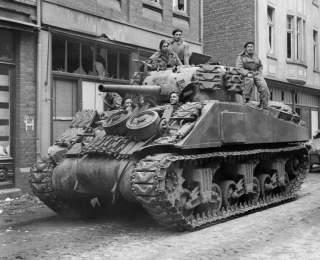Why the M-4 Sherman Tank Was Deadly (For the Operator, Not the Enemy)
Death trap?
Key point: The M-4 Sherman was easy to mass-produce, but easy to destroy.
The M-4 Sherman was the workhorse medium tank of the U.S. Army and Marine Corps during World War II. It fought in every theater of operation—North Africa, the Pacific and Europe.
The Sherman was renown for its mechanical reliability, owing to its standardized parts and quality construction on the assembly line. It was roomy, easily repaired, easy to drive. It should have been the ideal tank.
But the Sherman was also a death trap.
Most tanks at the time ran on diesel, a safer and less flammable fuel than gasoline. The Sherman’s powerplant was a 400-horsepower gas engine that, combined with the ammo on board, could transform the tank into a Hellish inferno after taking a hit.
All it took was a German adversary like the awe-inspiring Tiger tank with its 88-millimeter gun. One round could punch through the Sherman’s comparatively thin armor. If they were lucky, the tank’s five crew might have seconds to escape before they burned alive.
Hence, the Sherman’s grim nickname—Ronson, like the cigarette lighter, because “it lights up the first time, every time.”
In the new film Fury, a single Tiger tank devastates a platoon of Shermans advancing across Germany. Gus Stavros, a World War II veteran who witnessed actual combat between a Sherman and a Tiger outside of the town of Nennig, Germany, said the reality of pitched battle between the two tanks was just as horrifying.
“If you’ve seen movies where the people come out of the tank all aflame—I saw that,” Stavros said during a video interview for a combat oral history sponsored by the National Endowment for the Humanities.
“The German tank had an 88-[millimeter gun] and it just blew the General Sherman tank to pieces until there was nothing left but smoke and fire.”
The loss of both men and machines is hard to grasp. Simply put, in the heat of battle it was as dangerous inside of a Sherman tank as it was outside of one.
“The 3rd Armored Division entered combat in Normandy with 232 M-4 Sherman tanks,” writes Belton Cooper, author of the appropriately named Death Traps, a study of U.S. armored divisions and their battles in Europe during World War II.
“During the European Campaign, the Division had some 648 Sherman tanks completely destroyed in combat and had another 700 knocked out, repaired and put back into operation. This was a loss rate of 580 percent.”
Yet, the Sherman’s strength was in its numbers. It was one more example of the United States’ industrial prowess during World War II, a time where factory workers and factory output did as much to win the war for the Allies as the soldiers, sailors and airmen in battle.
Companies ranging from the Pullman Car Co. to Ford Motors cranked out nearly 50,000 Shermans, the second-most produced tank during the war. Only the Soviet Union outdid the U.S. in tank production at that time through manufacturing the legendary T-34.
In comparison, the Tiger—clearly the superior tank when compared to the Sherman—was made of costly materials, laboriously assembled and expensive to operate. The Germans manufactured slightly more than 1,300 Tigers.
The Tiger outmatched the Sherman, but the United States always had another Sherman to put in the field.
Whether there was another trained tank crew to man the Sherman was more problematic. But for all of its problems, infantrymen were always happy when a Sherman arrived.
Common roles included infantry support—often times, soldiers would stack up in long lines behind Shermans as the tanks advanced across open fields, leading the assault and letting armor block rounds fired from German MG-42 machine guns or small-arms fire from enemy soldiers.
The Sherman packed decent firepower. Although its 75-millimeter gun was less potent than German tank guns were, it still could fire high-explosive rounds that would level buildings sheltering German troops.
Additional weapons included two M1919 Browning .30-caliber machine guns and a Browning .50-caliber M2 on a coaxial turret mount. Both guns could mow down German infantry or destroy machine gun nests.
In the Pacific, Marines deployed Shermans equipped with flamethrowers to destroy Japanese defensive positions. In the last months of the war when die-hard Japanese soldiers rarely surrendered, shelling pillboxes often didn’t stop the withering fire directed at American troops.
Shermans modified to stream napalm through their gun muzzles blasted Japanese strongholds with jets of flame aimed at the enemy gun ports.
Despite its many weaknesses, the Sherman tank became a mainstay for both the U.S. military and armed forces around the world.
The Sherman tank remained in service with both the Army and the Marine Corps after World War II, and saw action throughout the Korean War. Even after the United States replaced the Sherman with the M48 Patton main battle tank during the 1950s, the Sherman served with U.S. allies until the 1970s.
Heavily-modified “Super Shermans” even saw combat with the Israeli Defense Force during the Six Day War in 1967 and the Yom Kippur War in 1973.
This first appeared several years ago.
Image: Wikimedia

